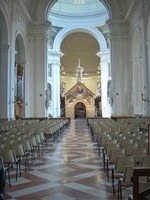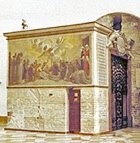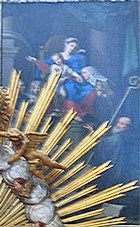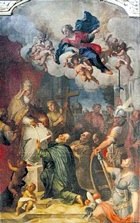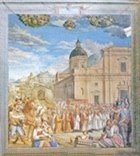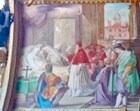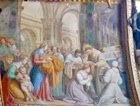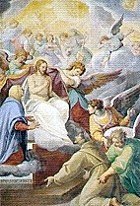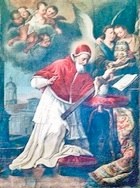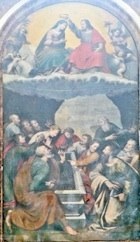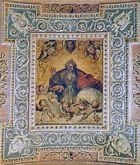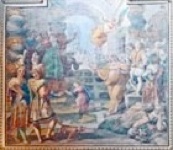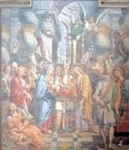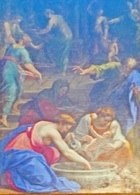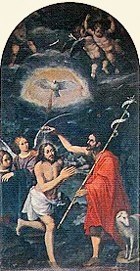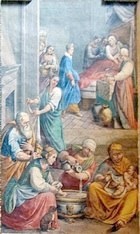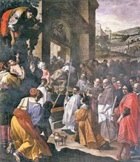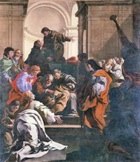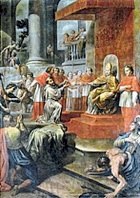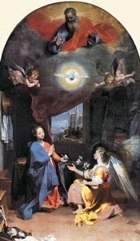The huge interior has a single nave with five chapels on each side, a transept and domed crossing, and a large presbytery. It also contains two structures that are closely associated with St Francis, each of which is described on its own page:
-
✴the Cappella della Portiuncula, under the crossing (illustrated above); and
-
Art in Santa Maria degli Angeli
The side chapels began to be completed and ceded to patrons from the the end of the 16th century, starting with those nearest the crossing. Their subsequent decoration brought together some of the most important Italian artists of the time. There is circumstantial evidence that Cardinal Bonifazio Bevilacqua, the papal legate to Umbria at the turn of the century, promoted this important programme of decoration: the artists Ventura Salimbeni and Simeone Ciburri, who worked here in 1602-3 (see below), both enjoyed his patronage.
Cappella del Rosario
This chapel (5th on the left), which was ceded in principal to the Commune of Perugia in 1577, was built in 1584. The Commune and the Perugian confraternities dedicated to SS Dominic, Augustine and Francis commissioned a panel depicting the Madonna and Child with saints for its altar from Giovanni Antonio Scaramuccia in 1610. However, by the time that the panel was delivered in 1617, the Perugians had exchanged this chapel for the larger Cappella di Sant’ Antonio di Padova (off the left transept), which was still in construction. The panel was therefore taken to the Chiesa dell Gesù in Perugia and then, in 1650, to the counter-facade of the Duomo, where it still hangs.
The present altarpiece (18th century) is attributed to
Domenico Maria Muratori. It depicts the Madonna and Child with SS Rufinus, Clare and Benedict. Two Franciscans to the left watch as the baby Jesus gives a rosary to St Clare.
The interesting panel (18th century) on the right wall, which depicts the architect Galeazzo Alessi submitting his design for Santa Maria degli Angeli to Pope Pius V, is signed by
Baldassarre Orsini. However, its history is more complicated than this suggests.
In fact, Baldassarre Orsini recorded in his memoirs that he and Carlo Spiridione Mariotti were commissioned to paint two panels for Cappella di San Diego d’ Alcalà (below) in 1787. These comprised:
-
✴this panel depicting Galeazzo Alessi submitting his design for Santa Maria degli Angeli to Pope Pius V; and
-
✴another depicting Pope Honorius confirming the Portiuncula Indulgence, which remains in the Cappella di San Diego d’ Alcalà. He adds that he finished this second panel in 1803, after a delay caused by sad circumstances. This was probably a reference to the death of Mariotti, which occurred in 1790.
Orsini says nothing more about the first panel. Although he signed it, it seems likely that Mariotti had largely completed it before his death. The circumstances in which it was moved to the Cappella del Rosario are unknown.
Cappella dell' Annunciazione
This chapel (5th on the right), which is now the Cappella del Presepio, was granted to Laura Pontani Coli of Perugia in 1591. She was the widow of Ludovico di Angelo Coli, a rich nobleman, and the niece of the celebrated jurist, Guglielmo Pontani. She promised to secure the decoration of the chapel by the following Easter, which suggests that she had already commissioned its altarpiece from Federico Barocci. However, Barocci was notoriously slow in delivering his work, and this seems to have been no exception. Francesco Federico Mancini (referenced below) has published a document that records that Laura Pontani pawned a farm in 1596 to pay “Federicum Baroccium pictorem famosissimum” for the altarpiece, presumably because it was finally about to be delivered. It is now above the door in the right transept (see below).
Frescoes (late 16th century)
There is no documentary record of the commissioning of the frescoes of the chapel, but Professor Mancini attributed them to a team that had been documented in San Pietro, Perugia in in the period December 1591 and May 1592: this team included Giovanni Battista Lombardelli, who was probably its leader, Silla Piccinini and Pietro Rancanelli. Lombardelli’s involvement would have been cut short by his death July 1592, and most of the frescoes are attributed to Silla Piccinini. (The attributions given below are those made in Professor Mancini’s paper.)
The fresco at the centre of the vaults depicts the granting of the Portiuncula Indulgence: in Franciscan iconography, this scene completed the story of salvation, which had begun with the Annunciation, the subject of the altarpiece of the chapel. This central scene is attributed to Giovanni Battista Lombardelli. The space around this central scene contains occupied by scenes from the life of St Francis, separated by personifications of Virtues:
-
✴The scene of the death of the Knight of Celano is attributed to Giovanni Battista Lombardelli.
-
✴The personification of Faith is attributed to Pietro Rancanelli (along with the figures of SS John the Evangelist and Matthew under the entrance arch).
Most of the other frescoes in the chapel are attributed to
Silla Piccinini. This includes those on the walls, which depict:
-
✴the procession of the Sacro Velo della Madonna (a procession involving the sacred veil of the Virgin, which is described in the page on the Sacro Velo della Madonna (on the left wall, illustrated here); and
-
✴the gift of Monte della Verna to St Francis (on the right wall).
The artist Antonio Castelletti restored and partially over-painted the frescoes in this chapel in 1828. A recent investigation has shown that the original fresco on the left wall originally showed the basilica while it was still in construction (notably, without its dome). Castelletti updated this part of the image, thus documenting the appearance of the basilica immediately before the earthquake of 1832.
Cappella della Deposizione
This chapel (3rd on the left) belonged to the Breccia-Vigilanti family.
Frescoes in the vaults (ca. 1602)
Two of the frescoes in the vaults (like some of those in the the family’s palace, now Palazzo Giacobetti Vallemani) are attributed to Ventura Salimbeni. He was documented in Perugia in 1602, and these frescoes probably also date to around this time. They depict:
-
✴the Resurrection; and
-
✴Pope Innocent IV visiting the dying St Clare.
A design by Ventura Salimbeni for a third fresco in the vaults survives in the
Chatsworth Collection, Derbyshire (number 377). However, the fresco itself, which depicts St Clare taking the habit, is attributed to
Baldassarre Croce.
Deposition (ca. 1602)
Cappella di San Pio V
This chapel (4th on the right) was dedicated to Pope Pius V, the pope who had commissioned the construction of the new church.
Frescoes (ca. 1602)
These frescoes, which are attributed to
Baldassarre Croce (although some have been over-painted), depict:
-
✴scenes from the life of the Virgin (in the vaults); and
-
✴scenes from the life of St Francis (on the walls), including a depiction of the granting of the Portiuncula Indulgence on the right wall (illustrated here).
St Pius V (early 17th century)
The altarpiece, which is by an unknown artist, depicts Pope Pius V adoring a crucifix, with the church of Santa Maria degli Angeli in the background.
Cappella della Incoronazione della Vergine
This chapel (4rd on the left) belonged to the Veglia family of Perugia.
Altarpiece and Frescoes (1603)
The altarpiece in this chapel is signed
by Simeone Ciburri and dated by inscription. It
is a free copy of the altarpiece (1505-25) that the nuns of Santa Maria di Monteluce, Perugia commissioned from
Raphael, which was executed by his workshop after his death.
The other panels in this chapel are attributed to Simeone Ciburri.
-
✴Those on the walls depict:
-
•St Diego of Alcalà posthumously curing Don Carlos, the son of King Philip II of Spain (a miracle reported in 1562, which culminated in the canonisation of St Diego in 1588); and
-
•SS Francis and Clare appearing to nuns and friars who share a meal at Santa Maria degli Angeli.
-
✴The main panel in the vaults depicts God the Father.
Cappella di Sant' Anna
This chapel (3rd on the right), which is also known as the Cappella della Natività della Vergine, belonged to the Breccia-Vigilanti family. It subsequently passed to the Fiumi-Roncalli family, who commissioned its decoration. The altarpiece is almost certainly the work of Cristoforo Roncalli, who was a member of this extended family. He may well have advised on the overall programme of decoration of the chapel, and probably recommended his young associate, Antonio Circignani for the execution of the frescoes.
Scenes from the lives of Christ and the Virgin (ca. 1602)
These frescoes are attributed to Antonio Circignani, il Pomarancio. (A self-portrait of the young artist appears behind the figure of King David). The main scenes include:
-
✴the presentation of the Virgin at the Temple (on the right wall); and
-
✴the marriage of the Virgin (on the left wall).
Birth of the Virgin (ca. 1605)
This altarpiece is attributed to
Cristoforo Roncalli, il Pomarancio; the composition is identical to a fresco that he executed (as part of a cycle of scenes from the life of the Virgin) in the Treasury of the Sanctuario della Santa Casa, Loreto in 1605-10.
Cappella di San Giovanni Battista
This chapel (2nd on the right) belonged to the Locatelli family, who financed its decoration from the estate of Bernardino Locatelli (died 1602).
Decoration of the Chapel (ca. 1608)
The decoration of this chapel is attributed to Cesare Sermei and dated with reference to his other early works in Assisi. It comprises:
-
✴the altarpiece, which depicts the Baptism of Christ (illustrated above, to the left);
-
✴the panels on the walls, which depict scenes from the life of St John the Baptist, including the scene of his birth (on the left wall, illustrated above, to the right); and
-
✴the frescoes in the vaults, which also depict scenes from the life of St John the Baptist.
Cappella delle Stimmate
This chapel (2nd on the left) was ceded to the Franciscan Third Order in 1624 and decorated using money that Livio Nuti had left to the confraternity for this purpose in 1599. The work, which was commissioned from Cesare Sermei and Giacomo Giorgetti, was apparently complete by ca. 1631. The surviving documents do not specify which artist did which work; the following attributions are made on stylistic grounds.
Work Attributed to Cesare Sermei
-
✴the panel of St Clare and her sisters grieving over the body of St Francis outside San Damiano (on the right wall, illustrated here);
-
✴the fresco of the Approval of the Franciscan Rule (in the vault); and
-
✴the fresco of St Francis welcomed in Heaven (also in the vault).
Work Attributed to Giacomo Giorgetti
-
✴the panel of the Verification of the Stigmata (on the left wall, illustrated here);
-
✴the fresco of Tertiaries taking the Franciscan habit (in the vault); and
-
✴the altarpiece depicting Stigmatisation of St Francis
Cappella di Sant' Antonio Abate
The Confraternita di SS Giacomo e Antonio Abate acquired this chapel (1st on the right) in 1664.
St Antony Abbot (1670-5)
Payments to Giacomo Giorgetti for this altarpiece are documented in 1670 and in 1675.
Frescoes (1756)
These documented frescoes in the vaults by Francesco Appiani depict:
-
✴St Antony Abbot in glory; and
-
✴the Cardinal Virtues.
Miracle of St Antony Abbot (1773)
This documented fresco on the left wall by Antonio Maria Garbi depicts St Antony Abbot reviving a dead child. (Antonio Maria Garbi also painted a fresco on the right wall, but this was later destroyed).
Cappella di San Diego d’ Alcalà
This chapel (1st on the left) [more]
Frescoes (1773)
The frescoes in the vaults by Antonio Maria Garbi depict:
-
✴St Diego in glory; and
-
✴the Cardinal Virtues.
Pope Honorius III Confirms the Portiuncula Indulgence (1787-1803)
As noted above,
Baldassarre Orsini recorded in his memoirs that he and
Carlo Spiridione Mariotti were commissioned to paint two panels for this chapel in 1787. He goes on to say that he finished this one in 1803, after a delay caused by sad circumstances. This was probably a reference to the death of Mariotti, which occurred in 1790. The panel, which is signed by Baldassarre Orsini and dated 1787, seems to be essentially his work.
(For details of the second panel, which was probably largely the work of Carlo Spiridione Mariotti, see the Cappella del Rosario above).
Right Transept
Annunciation (1596)
Laura Pontani Coli of Perugia commissioned this altarpiece for the the Cappella dell' Annunciazione (see above) from
Federico Barocci. She was ceded the chapel in 1591 and promised to secure its decoration by the following Easter, which suggests that she had already commissioned the altarpiece. However, Barocci was notoriously slow in delivering his work, and this seems to have been no exception.
Francesco Federico Mancini (referenced below) has published a document that records that Laura Pontani pawned a farm in 1596 to pay “
Federicum Baroccium pictorem famosissimum” for the altarpiece, presumably because it was finally about to be delivered. This document strongly supports the attribution of the altarpiece to Federico Barocci himself rather than to one of his followers.
The altarpiece, which is now above the door in the right transept, is based on the Annunciation (1582-4) that Barocci painted for the chapel of Francesco Maria II della Rovere in the Basilica della Santa Casa, Loreto, which is now in the Pinacoteca Vaticana. (This link to the Web Gallery of Art also has a copy of the image at Santa Maria degli Angeli, which it erroneously says is in Perugia). Both works are set in a darkened room, with a curtain raised at the window to reveal a view of the ducal palace of Urbino. A kitten sleeps on a chair at the bottom left.
Christ in Glory with Saints (1760)
This altarpiece by Francesco Appiani, which is on the Altare di SS Pietro d’ Alcantara and Margherita da Cortona depicts Christ appearing to SS Peter of Alcantara and Margaret of Cortona.
Crossing
Frescoes (1757)
These frescoes by Francesco Appiani in the pendentives under the cupola depict:
-
✴the friars at the Portiuncula renouncing their possessions;
-
✴the Benedictines granting the Portiuncula to St Francis;
-
✴St Clare taking the habit at the Portiuncula; and
-
✴St Bonaventure writing the “Legenda Sancti Francisci”, visited by St Thomas Aquinas.
Tomb of Teresa Pamphili Grillo (1764)
This funerary monument is on the 1st pier on the left in the crossing. Cardinal Cosimo Imperiali commissioned it from Tommaso Righi for his cousin, the Principessa Teresa Pamphili Grill. (She had bought Villa Fidelia, Spello in 1736, apparently wishing to escape from a troubled marriage to Filippo Camillo Pamphili, and died there in 1762). The monument was made in Rome and attracted excellent reviews there before it was sent to Assisi. The sculptor Giuseppe Franchi seems to have supervised the erection of the tomb and he might have been associated with its execution.
Crypt
A door in the right transept leads to the sacristy and to the crypt, which was built in 1968 to expose the remains of the first conventual buildings that were discovered at that time.
Sacristy
A door in the left-hand side of the right transept leads to a corridor, with the sacristy opposite. The painting to the right of the entrance of the Redeemer (16th century) is attributed to Berto di Giovanni.
Art from the Church
A number of important works of art from the church are now in the Museo della Portiuncula.


